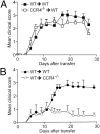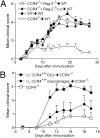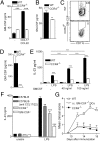CC chemokine receptor 4 is required for experimental autoimmune encephalomyelitis by regulating GM-CSF and IL-23 production in dendritic cells
- PMID: 22355103
- PMCID: PMC3309768
- DOI: 10.1073/pnas.1114153109
CC chemokine receptor 4 is required for experimental autoimmune encephalomyelitis by regulating GM-CSF and IL-23 production in dendritic cells
Abstract
Dendritic cells (DCs) are pivotal for the development of experimental autoimmune encephalomyelitis (EAE). However, the mechanisms by which they control disease remain to be determined. This study demonstrates that expression of CC chemokine receptor 4 (CCR4) by DCs is required for EAE induction. CCR4(-/-) mice presented enhanced resistance to EAE associated with a reduction in IL-23 and GM-CSF expression in the CNS. Restoring CCR4 on myeloid cells in bone marrow chimeras or intracerebral microinjection of CCR4-competent DCs, but not macrophages, restored EAE in CCR4(-/-) mice, indicating that CCR4(+) DCs are cellular mediators of EAE development. Mechanistically, CCR4(-/-) DCs were less efficient in GM-CSF and IL-23 production and also T(H)-17 maintenance. Intraspinal IL-23 reconstitution restored EAE in CCR4(-/-) mice, whereas intracerebral inoculation using IL-23(-/-) DCs or GM-CSF(-/-) DCs failed to induce disease. Thus, CCR4-dependent GM-CSF production in DCs required for IL-23 release in these cells is a major component in the development of EAE. Our study identified a unique role for CCR4 in regulating DC function in EAE, harboring therapeutic potential for the treatment of CNS autoimmunity by targeting CCR4 on this specific cell type.
Conflict of interest statement
The authors declare no conflict of interest.
Figures





Comment in
-
Effect of CC chemokine receptor 4 antagonism on the evolution of experimental autoimmune encephalomyelitis.Proc Natl Acad Sci U S A. 2012 Sep 11;109(37):E2412-3; author reply E2414. doi: 10.1073/pnas.1209124109. Epub 2012 Aug 3. Proc Natl Acad Sci U S A. 2012. PMID: 22864916 Free PMC article. No abstract available.
Similar articles
-
Effect of CC chemokine receptor 4 antagonism on the evolution of experimental autoimmune encephalomyelitis.Proc Natl Acad Sci U S A. 2012 Sep 11;109(37):E2412-3; author reply E2414. doi: 10.1073/pnas.1209124109. Epub 2012 Aug 3. Proc Natl Acad Sci U S A. 2012. PMID: 22864916 Free PMC article. No abstract available.
-
Chemokine CCL17 is expressed by dendritic cells in the CNS during experimental autoimmune encephalomyelitis and promotes pathogenesis of disease.Brain Behav Immun. 2017 Nov;66:382-393. doi: 10.1016/j.bbi.2017.06.010. Epub 2017 Jun 19. Brain Behav Immun. 2017. PMID: 28642092
-
IL-9 Controls Central Nervous System Autoimmunity by Suppressing GM-CSF Production.J Immunol. 2020 Feb 1;204(3):531-539. doi: 10.4049/jimmunol.1801113. Epub 2019 Dec 18. J Immunol. 2020. PMID: 31852750 Free PMC article.
-
The C-C Chemokines CCL17 and CCL22 and Their Receptor CCR4 in CNS Autoimmunity.Int J Mol Sci. 2017 Nov 2;18(11):2306. doi: 10.3390/ijms18112306. Int J Mol Sci. 2017. PMID: 29099057 Free PMC article. Review.
-
Involvement of the IL-1 system in experimental autoimmune encephalomyelitis and multiple sclerosis: Breaking the vicious cycle between IL-1β and GM-CSF.Brain Behav Immun. 2017 May;62:1-8. doi: 10.1016/j.bbi.2016.07.146. Epub 2016 Jul 16. Brain Behav Immun. 2017. PMID: 27432634 Review.
Cited by
-
Gasdermin D in peripheral myeloid cells drives neuroinflammation in experimental autoimmune encephalomyelitis.J Exp Med. 2019 Nov 4;216(11):2562-2581. doi: 10.1084/jem.20190377. Epub 2019 Aug 29. J Exp Med. 2019. PMID: 31467036 Free PMC article.
-
The Role of Granulocyte-Macrophage Colony-Stimulating Factor in Murine Models of Multiple Sclerosis.Cells. 2020 Mar 4;9(3):611. doi: 10.3390/cells9030611. Cells. 2020. PMID: 32143326 Free PMC article. Review.
-
Translational utility of experimental autoimmune encephalomyelitis: recent developments.J Inflamm Res. 2015 Nov 13;8:211-25. doi: 10.2147/JIR.S76707. eCollection 2015. J Inflamm Res. 2015. PMID: 26622189 Free PMC article. Review.
-
Effect of CC chemokine receptor 4 antagonism on the evolution of experimental autoimmune encephalomyelitis.Proc Natl Acad Sci U S A. 2012 Sep 11;109(37):E2412-3; author reply E2414. doi: 10.1073/pnas.1209124109. Epub 2012 Aug 3. Proc Natl Acad Sci U S A. 2012. PMID: 22864916 Free PMC article. No abstract available.
-
Accumulation of FLT3(+) CD11c (+) dendritic cells in psoriatic lesions and the anti-psoriatic effect of a selective FLT3 inhibitor.Immunol Res. 2014 Oct;60(1):112-26. doi: 10.1007/s12026-014-8521-4. Immunol Res. 2014. PMID: 24895100
References
-
- Lassmann H. Models of multiple sclerosis: New insights into pathophysiology and repair. Curr Opin Neurol. 2008;21:242–247. - PubMed
-
- Steinman L, Zamvil SS. How to successfully apply animal studies in experimental allergic encephalomyelitis to research on multiple sclerosis. Ann Neurol. 2006;60:12–21. - PubMed
-
- Wekerle H. Lessons from multiple sclerosis: Models, concepts, observations. Ann Rheum Dis. 2008;67(Suppl 3):iii56–iii60. - PubMed
-
- Segal BM. Experimental autoimmune encephalomyelitis: Cytokines, effector T cells, and antigen-presenting cells in a prototypical Th1-mediated autoimmune disease. Curr Allergy Asthma Rep. 2003;3:86–93. - PubMed
-
- Miller SD, McMahon EJ, Schreiner B, Bailey SL. Antigen presentation in the CNS by myeloid dendritic cells drives progression of relapsing experimental autoimmune encephalomyelitis. Ann N Y Acad Sci. 2007;1103:179–191. - PubMed
Publication types
MeSH terms
Substances
LinkOut - more resources
Full Text Sources
Molecular Biology Databases

